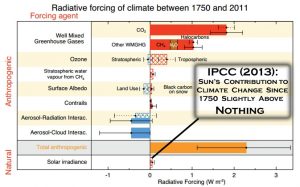By Kenneth Richard on 23. January 2017
One of the oft-stated “truths” for advocates of the position that humans are predominantly responsible for climate changes is that the Sun could not have played more than a negligible role in the global warming of the last few centuries. Indeed, the latest Intergovernmental Panel on Climate Change (IPPC) report theorizes that the long-term solar contribution to climate change has been slightly above zero.
IPCC AR5:
And yet today’s scientists have not been deterred in their quest to document a robust Sun-Climate link in the paleoclimate data… as well as in the temperature and climatic changes for recent decades. In 2016 alone, for example, there were over 130 scientific papers documenting a non-negligible solar influence on climate.
Climate scientist Dr. Jianyong Li, who has himself authored over 300 peer-reviewed scientific publications, continues this trend of linking climate changes to solar forcing. He and 13 other scientists just published a new paper in the journal Quaternary Science Reviews in which they have clearly affirmed the dominance of the Sun’s forcing on the climate of China (and for the Northern Hemisphere in general) during the past few thousand years, including the last century. The authors assert that climate changes and solar activity are well correlated throughout the paleoclimate record, and that if there is a role for greenhouse gases to influence climatic trends, that role is merely supplementary, not dominant. They also describe in detail how the Sun’s variance acts to influence atmospheric and oceanic heat oscillations, and how this may affect regional precipitation, weather, and temperature changes.
Li et al., 2017
Summary
“We suggest that solar activity may play a key role in driving the climatic fluctuations in NC [North China] during the last 22 centuries, with its quasi ∼100, 50, 23, or 22-year periodicity clearly identified in our climatic reconstructions. … It has been widely suggested from both climate modeling and observation data that solar activity plays a key role in driving late Holocene climatic fluctuations by triggering global temperature variability and atmospheric dynamical circulation (e.g., Haigh, 1996; Shindell et al., 1999; Bond et al., 2001; Fleitmann et al., 2003; Dykoski et al., 2005).”
Climate Changes/Oscillations And Solar Activity Well Correlated For North China, Northern Hemisphere
“Spectral analyses indicate that the PANN [annual precipitation] record has significant periodicities at 100, 67, 57 and 23 years; and the TANN [annual temperature] record displays notable periodicities at 118, 103, 80, 67, 56, 50, 40 and 22 years (Fig. 4). The 100, 57 and 23 year periods for PANN, as well as the 103, 50, and 22 year periods for TANN, correlate well with the 100, 50, 23 and 22 year cycles for the solar activity observed in various solar parameters (e.g., Wilson et al., 1996; Li et al., 1996; Chowdhury et al., 2009; Zhang et al., 2014), therefore implying an in-phase relationship between the climatic oscillation in NC [North China] and solar activity. Furthermore, a multidecadal to centennial comparison of our pollen-derived TANN reconstruction for NC with the Total Solar Irradiance (TSI; Vieira et al., 2011), the Asian Pacific Oscillation index (APO; Zhou et al., 2009), the Intertropical Convergence Zone index (ITCZ; Haug et al., 2001), the North Atlantic Oscillation index (NAO; Trouet et al., 2009; Olsen et al., 2012) and the Ice-Rafted Debris record (IRD; Bond et al., 2001) from the North Atlantic Ocean, suggests a strong underlying teleconnection between the EAM [East Asian Monsoon] regime in NC and many other high- or low-latitude climatic systems in different regions of the northern Hemisphere.”
– See more at: http://notrickszone.com/2017/01/23/new-paper-14-scientists-affirm-solar-forcing-not-co2-is-dominant-control-for-modern-climate-change/#sthash.UIoONWvT.dpuf





